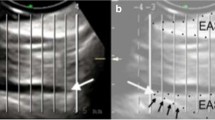Abstract
The aim of the study was to compare the main body of the external anal sphincter (EAS) cross-sectional area (CSA) of women with and without pelvic organ prolapse. Pelvic magnetic resonance imaging (MRI) scans of 40 women were selected for analysis. Of these women, 20 had pelvic organ prolapse and 20 had normal support. Of the women with normal support, 10 had known major levator ani (LA) muscle defects and 10 had normal LA muscles. The same was true for the women with pelvic prolapse: half had major LA defects and half had no LA defects. All patients had previously completed pelvic MRI in the supine position. 3-D models of the EAS were made and CSA of the EAS perpendicular to the fiber direction were measured circumferentially at 30° intervals. Univariable and multivariable analyses were performed. The mean CSA did not significantly differ between women with prolapse and normal support regardless of LA defect status (normal/−LA defect = 1.13 cm2, prolapse/−LA defect = 0.86 cm2, p = 0.065; normal/+LA defect = 1.08 cm2, prolapse/+LA defect = 1.28 cm2, p = 0.28). Women with prolapse and LA defects had a 49% larger mean muscle CSA compared to prolapse patients without LA defects (p = 0.01). This difference associated with defect status in prolapse patients was not seen in women with normal support. Women with prolapse alone had external anal sphincter CSAs that were comparable to women with normal support. However, women with both prolapse and a major levator ani defect had larger external anal sphincter CSAs compared to prolapse patients without levator ani defects.



Similar content being viewed by others
References
Hsu Y, Weadock W, Fenner DE, DeLancey JOL (2005) MRI and 3-dimensional analysis of external anal sphincter subdivisions: are there two, three, or four parts? Obstet Gynecol 106(6):1259–1265
Nichols CM, Ramakrishnan V, Gill EJ, Hurt WG (2005) Anal incontinence in women with and those without pelvic floor disorders. Obstet Gynecol 106(6):1266–1271
Ikai M, Fukunaga T (1968) Calculation of muscle strength per unit cross-sectional area of human muscle by means of ultrasonic measurement. Int Z Angew Physiol 26(1):26–32
Ikai M, Fukunaga T (1970) A study on training effect on strength per unit cross-sectional area of muscle by means of ultrasonic measurement. Int Z Angew Physiol 28(3):173–180
Hsu Y, Chen L, Huebner M, Ashton-Miller JA, DeLancey JOL (2006) Quantification of levator ani cross-sectional area differences between women with and those without prolapse. Obstet Gynecol 108(4):879–883
Terra MP, Deutekom M, Beets-Tan RG, Engel AF, Janssen LWM, Boeckxstaens GE et al (2006) Relationship between external anal sphincter atrophy at endoanal magnetic resonance imaging and clinical, functional, and anatomic characteristics in patients with fecal incontinence. Dis Colon Rectum 49(5):1–11
Cazemier M, Terra MP, Stoker J, de Lange-de Klerk ES, Boeckxstaens GE, Mulder CJ et al (2005) Atrophy and defects detection of the external anal sphincter: Comparison between three-dimensional anal endosonography and endoanal magnetic resonance imaging. Dis Colon Rectum 49(1):20–27
Gregory WT, Boyles SH, Simmons K, Corcoran A, Clark AL (2006) External anal sphincter volume measurements using 3-dimensional endoanal ultrasound. Am J Obstet Gynecol 194(5):1243–1248
Fritsch H, Brenner E, Lienemann A, Ludwikowski B (2002) Anal sphincter complex: reinterpreted morphology and its clinical relevance. Dis Colon Rectum 45(2):188–194
Cornella JL, Hibner M, Fenner DE, Kriegshauser JS, Hentz J, Magrina JF (2003) Three-dimensional reconstruction of magnetic resonance images of the anal sphincter and correlation between sphincter volume and pressure. Am J Obstet Gynecol 189(1):130–135
Hoyte L, Ratiu P (2001) Linear measurements in 2-dimensional pelvic floor imaging: the impact of slice tilt angles on measurement reproducibility. Am J Obstet Gynecol 185(3):537–544
Lien KC, Mooney B, DeLancey JOL, Ashton-Miller JA (2004) Levator ani muscle stretch induced by simulated vaginal birth. Obstet Gynecol 103(1):31–40
Acknowledgements
We gratefully acknowledge the support of the NIH (NICHD: RO1 HD-38665) and the German Research Foundation (Deutsche Forschungsgemeinschaft-DFG).
Author information
Authors and Affiliations
Corresponding author
Rights and permissions
About this article
Cite this article
Hsu, Y., Huebner, M., Chen, L. et al. Comparison of the main body of the external anal sphincter muscle cross-sectional area between women with and without prolapse. Int Urogynecol J 18, 1303–1308 (2007). https://doi.org/10.1007/s00192-007-0340-x
Received:
Accepted:
Published:
Issue Date:
DOI: https://doi.org/10.1007/s00192-007-0340-x




